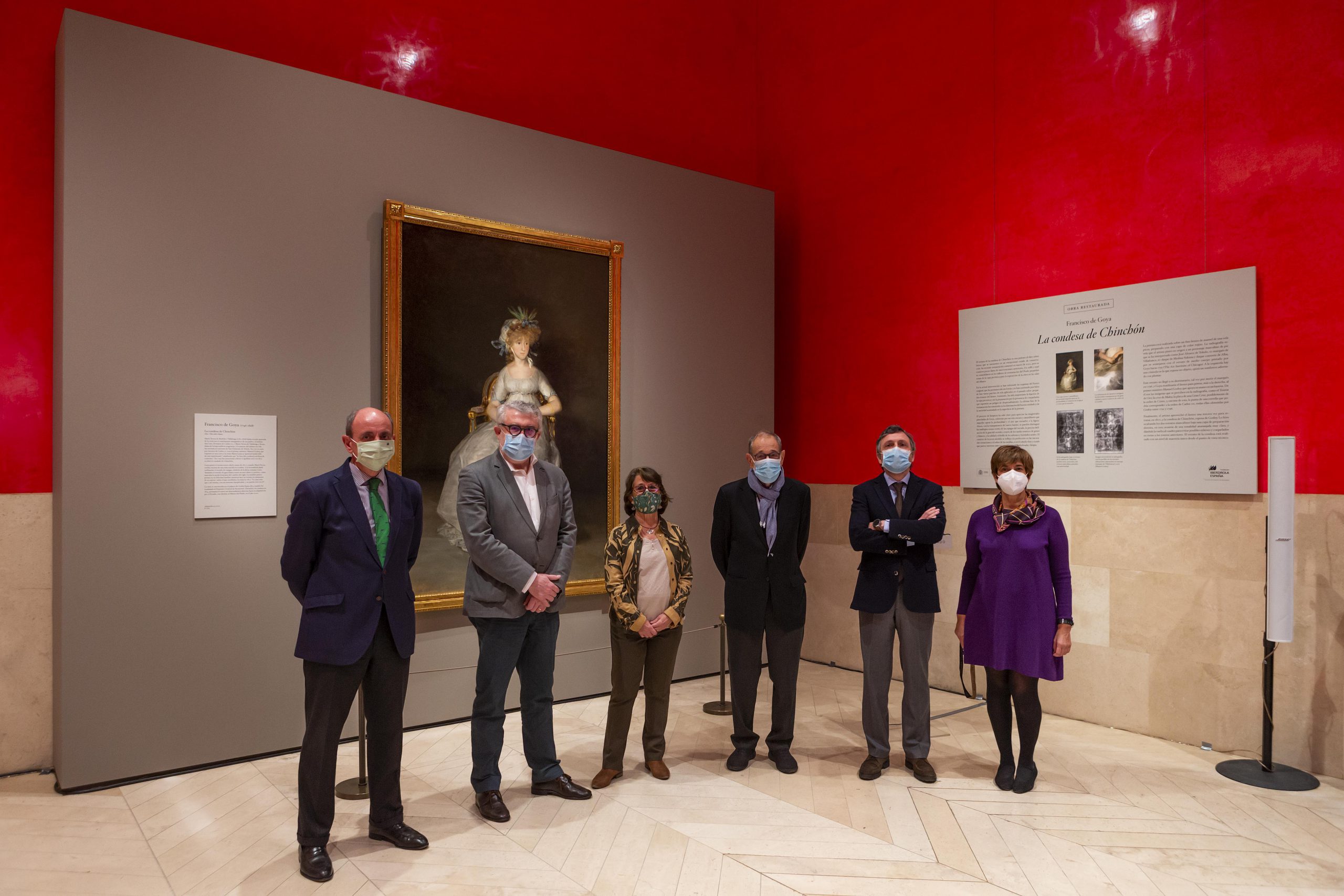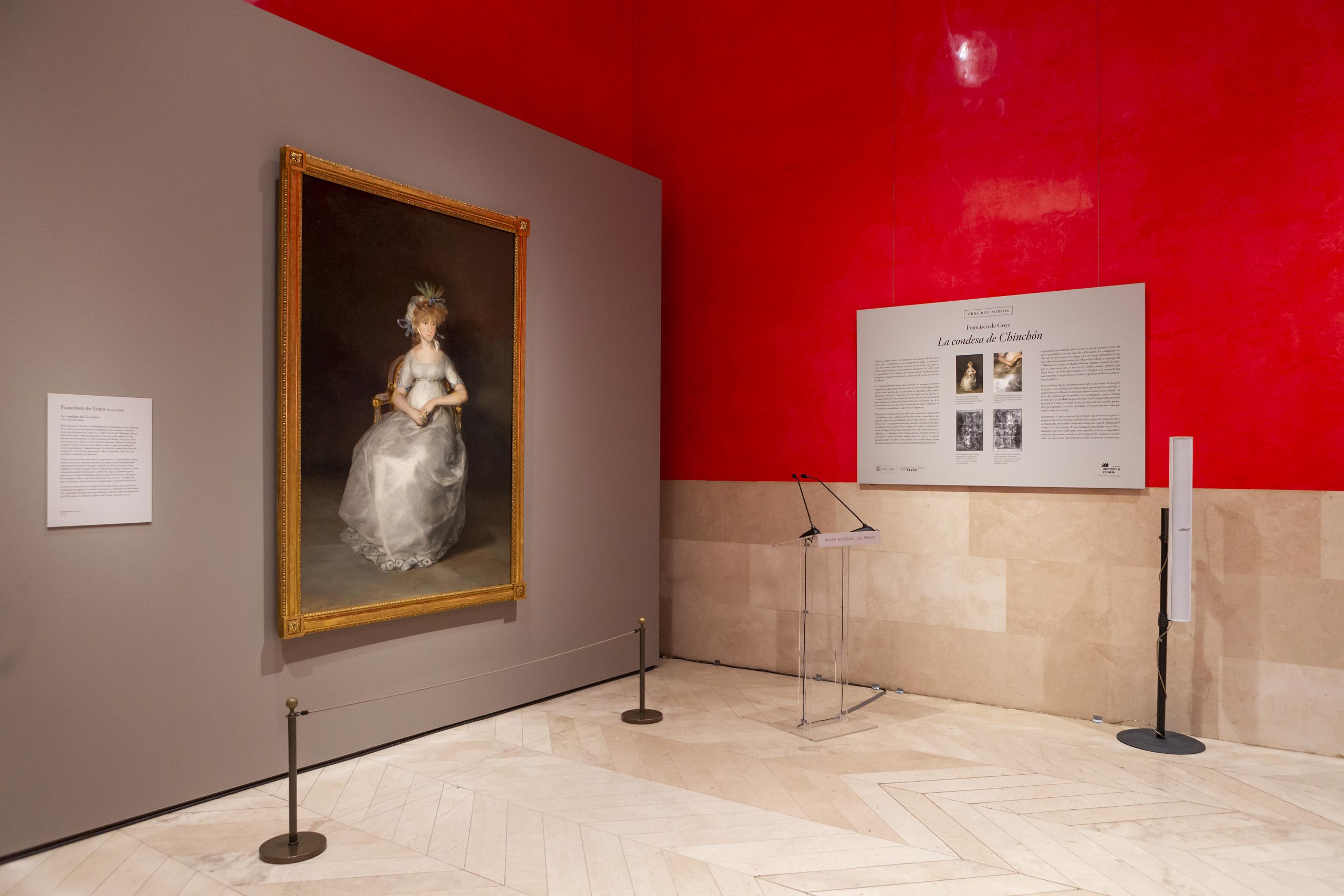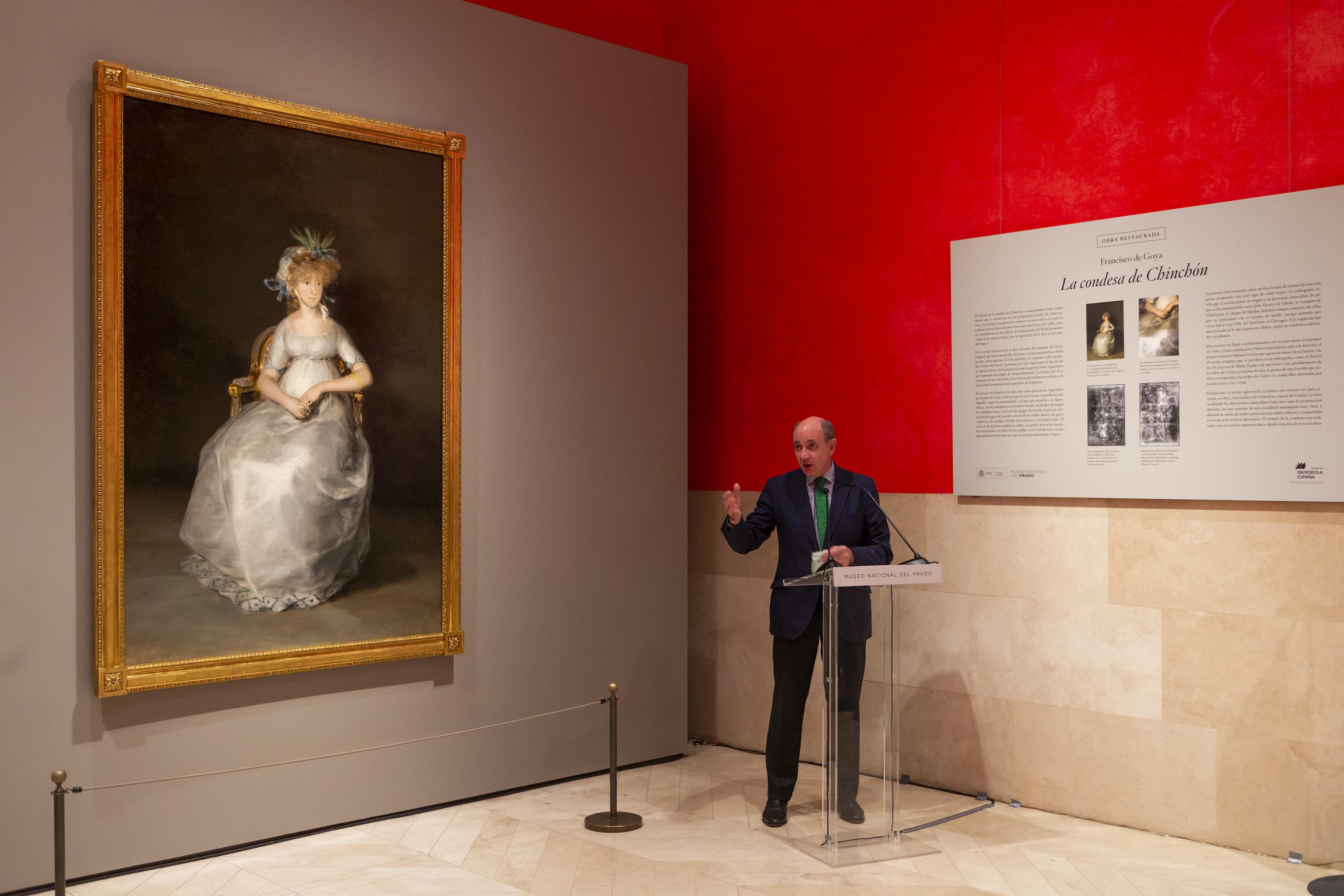- This quintessential court portrait has undergone a process of fixing the pictorial layer and removing the oxidised varnish and dirt accumulated on the surface of the painting with the collaboration of the Iberdrola España Foundation, a Protector member of the Museo del Prado’s Restoration Programme.
- This intervention has made it possible to recover the original values of the work and to appreciate Goya’s masterly brushstrokes, covered by a dark, yellowish veil that prevented the depth and air of the space surrounding the figure from being captured.
Madrid, 23 December 2020
The Museo Nacional del Prado today presents The Countess of Chinchón by Goya after having been restored as part of the programme sponsored by the Fundación Iberdrola España as a Protector member of the museum.
The work, documented in Godoy’s palace in 1800, was transferred in 1813 to the General Deposit of Sequestered Goods, located in the warehouse that the Fábrica de Cristales de San Ildefonso had in calle Alcalá. In 1814 it was placed in the palace in Boadilla del Monte (Madrid) among the assets returned to the Countess of Chinchón and remained in the possession of her direct descendants until it was incorporated into the Prado collections in 2000, thanks to the acquisition of the work with State funds and a contribution from the Museo Nacional del Prado itself from the bequest of Manuel Villaescusa.
This restoration, carried out by Elisa Mora, has made it possible to recover the green tones of the ears of corn on the headdress, the precise quality of the gauze of the dress and its embroidered ornaments and the subtle shades of grey and white.
After 38 years in the restoration workshops of the Museo Nacional del Prado, Elisa Mora faces her retirement with the satisfaction of having worked on the recovery of the original values of great works of universal art such as Goya’s El 2 de mayo; El vino de la fiesta de San Martín by Bruegel the Elder; or La Dolorosa con manos de San Martín by Bruegel the Elder; or La Dolorosa con las manos abiertas by Tiziano, painted on marble, and having been awarded, along with the rest of the Museo Nacional del Prado’s Restoration team, the 2019 National Prize for the Restoration and Conservation of Cultural Heritage, granted by the Ministry of Culture and Sport.
The restoration
The portrait of The Countess of Chinchón is an oil painting on canvas in an exceptional state of conservation. Its recent restoration began in March 2020, but little is known of previous interventions. In 1988 and 1996 small areas of the pictorial layer were consolidated in the Prado’s workshops for the exhibition of the work in the Museum. After its acquisition in 2000, a technical study revealed that it was painted on top of a canvas already used by Goya, in which a standing portrait of Godoy and a less visible, underlying portrait of a young knight wearing the cross of the Order of Saint John of Malta on his chest can be fully identified in the X-radiograph. Both were covered by a pinkish-beige cloak, used in preparation for the final portrait of the Countess of Chinchón.
The current intervention has reinforced the corners of the original canvas, which is uncovered, and several patches of cloth applied in the past over small tears have been replaced with linen thread. It was important to fix the pictorial layer and the preparation, due to the presence of craquelure that posed a risk of detachment. The last phase of the restoration consisted of removing the oxidised varnish and the dirt accumulated on the surface of the painting.
The cleaning process has been key to appreciating Goya’s masterly brushstrokes, which were covered by a dark, yellowish veil that prevented the depth and air of the space surrounding the figure from being captured. Now, with the transparency of the new varnish, it is possible to distinguish the green tones of the spikes on the headdress, the precise quality of the gauze of the dress and its embroidered ornaments, and the subtle shades of grey and white. The pearly flesh tones and the blush on her cheeks and the fine, curly hair that seems to move before her eyes with their rapt, clear gaze perfectly describe the character of the young countess.
The Countess of Chinchón. Goya
The portrait of the Countess of Chinchón is documented in the correspondence between María Luisa and Godoy between 22 April and early May 1800, when the Queen was finalising preparations for Goya to paint The Family of Charles IV in Aranjuez. It is known from the letters that Maria Teresa was pregnant again, two previous pregnancies having been frustrated. A baby girl, Carlota Joaquina, was born on 2 October of that year, and was sponsored by the king and queen.
The young woman’s headdress, with its ears of wheat, was in keeping with the fashion for women’s adornments of those years, which included flowers and fruit, but here it has the added significance of being an emblem of fertility, being the symbol of the goddess Ceres, whose festivals were celebrated in ancient Rome precisely in the month of April in which the painting was painted.
Depicted in accordance with the high rank she now held, full-length, seated in a gilded armchair that resembles the throne of her ancestors, as the granddaughter of Philip V, and awaiting the heir who was to be both son of the Prince of Peace and descendant of the house of Bourbon, Goya was able to capture all the naivety and candour depicted by Godoy in his letters. On the left hand he wears a ring, whose precise, well-defined central brushstroke highlights the brilliance of the diamond, and on the right another, on the middle finger, adorned with the miniature of a very sketchy male portrait wearing the blue sash of the order of Charles III.
The half-light that surrounds her is far removed from the light of the portraits of other aristocratic ladies and recalls, with its Velázquez-like use of dense shadows and the illuminated figure, some contemporary prints from the Caprichos.
The figure is subjected to a rigorous geometry and the folds of her gauze dress create a set of richly criss-crossed planes that suggest volume and increase its luminosity. The floating spikes and blue ribbons seem to move, revealing the slightest movement of her head, and the white ribbon of stiff organdy, which holds the bonnet under her chin, projects a rigid ribbon under her face which, with its three white brushstrokes, full of matter, emphasises the rosy colouring of the young woman, the fineness of her face, as well as her sweetness and the nervous and repressed expressiveness of her personality. Although the fluidity of the technique, the lightness of the brushstrokes and the little material used to paint it stand out, revealing the warm, pinkish preparation in many areas, there is nevertheless an elaboration of the figure in all its details, which Goya completed with rigorous technical precision and dense material, perhaps used to conceal the fact that he had used a used canvas for such an important patron in which there were already two fairly finished portraits of an unknown gentleman and of Godoy himself.
The Countess of Chinchón
María Teresa de Borbón y Vallabriga, born on 26 November 1780 in Velada, was the daughter of Prince Luis de Borbón, brother of Charles III, and María Teresa de Vallabriga, a lady of the Aragonese nobility. Removed from the court from birth along with her siblings, and unable to use the surname of Bourbon by the Pragmatic Sanction of Charles III, on the death of her father in 1785 she was sent with her sister to the convent of San Clemente in Toledo, from where she left to marry Godoy on 2 October 1797.
The marriage was decided by decree of Charles IV. The young María Teresa, then sixteen years old, after being consulted, agreed to the marriage, which restored family harmony in the House of Bourbon and rehabilitated the three brothers and their mother, restoring their royal surname and titles. On the other hand, the king and queen were honouring Godoy, their most trusted man, by linking him to royalty.



